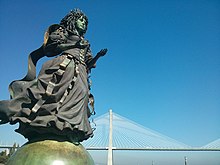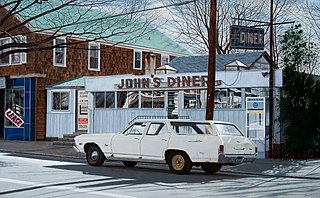
Photorealism is a genre of art that encompasses painting, drawing and other graphic media, in which an artist studies a photograph and then attempts to reproduce the image as realistically as possible in another medium. Although the term can be used broadly to describe artworks in many different media, it is also used to refer specifically to a group of paintings and painters of the American art movement that began in the late 1960s and early 1970s.
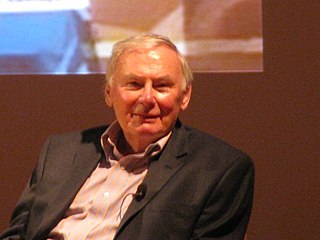
Richard Estes is an American artist, best known for his photorealist paintings. The paintings generally consist of reflective, clean, and inanimate city and geometric landscapes. He is regarded as one of the founders of the international photo-realist movement of the late 1960s, with such painters as John Baeder, Chuck Close, Robert Cottingham, Audrey Flack, Ralph Goings, and Duane Hanson. Author Graham Thompson writes "One demonstration of the way photography became assimilated into the art world is the success of photorealist painting in the late 1960s and early 1970s. It is also called super-realism or hyper-realism and painters like Richard Estes, Denis Peterson, Audrey Flack, and Chuck Close often worked from photographic stills to create paintings that appeared to be photographs."

Ralph Goings was an American painter closely associated with the Photorealism movement of the late 1960s and early 1970s. He was best known for his highly detailed paintings of hamburger stands, pick-up trucks, and California banks, portrayed in a deliberately objective manner.
Events from the year 1977 in art.

Alma Woodsey Thomas was an African-American artist and teacher who lived and worked in Washington, D.C., and is now recognized as a major American painter of the 20th century. Thomas is best known for the "exuberant", colorful, abstract paintings that she created after her retirement from a 35-year career teaching art at Washington's Shaw Junior High School.
Denis Peterson is an American hyperrealist painter whose photorealist works have been exhibited at the Brooklyn Museum, Whitney Museum of American Art, Butler Institute of American Art, Tate Modern, Springville Museum of Art, Corcoran MPA, Museum of Modern Art CZ and Max Hutchinson Gallery in New York.

Glennray Tutor is an American painter who is known for his photorealistic paintings. He is considered to be part of the Photorealism art movement. His paintings are immersed with bright colors, nostalgic items, metaphor, and with a complete focus on detail. Tutor is a graduate of the University of Mississippi where he received his Bachelor of Arts degree in Art and English in 1974 and his Master of Fine Arts degree in Painting in 1976.

Hyperrealism is a genre of painting and sculpture resembling a high-resolution photograph. Hyperrealism is considered an advancement of photorealism by the methods used to create the resulting paintings or sculptures. The term is primarily applied to an independent art movement and art style in the United States and Europe that has developed since the early 1970s. Carole Feuerman is the forerunner in the hyperrealism movement along with Duane Hanson and John De Andrea.
Robert Alan Bechtle was an American painter, printmaker, and educator. He lived nearly all his life in the San Francisco Bay Area and whose art was centered on scenes from everyday local life. His paintings are in a Photorealist style and often depict automobiles.
Mary Frank is an English visual artist who works as a sculptor, painter, printmaker, draftswoman, and illustrator.
Idelle Lois Weber was an American artist most closely aligned with the Pop art and Photorealist movements.

Robert Neffson is an American painter known for his photorealistic street scenes of various cities around the world, museum interiors and for early still lifes and figure paintings.

The Nassau County Museum of Art (NCMA) is located on the former Frick "Clayton" Estate, a 145-acre (59 ha) property in Roslyn Harbor on the Gold Coast of Long Island, New York. The main museum building, named in honor of art collectors and philanthropists Arnold A. Saltzman and his wife Joan, is a three-story Georgian-style mansion that exemplifies Gold Coast architecture of the late 19th century. In addition to the mansion, NCMA, which receives nearly 200,000 visitors each year, includes The Manes Family Art & Education Center, opened in 2017, as well as a Sculpture Park, a Formal Garden, rare specimen trees and marked walking trails.

Janet Fish is a contemporary American realist artist. Through oil painting, lithography, and screenprinting, she explores the interaction of light with everyday objects in the still life genre. Many of her paintings include elements of transparency, reflected light, and multiple overlapping patterns depicted in bold, high color values. She has been credited with revitalizing the still life genre.
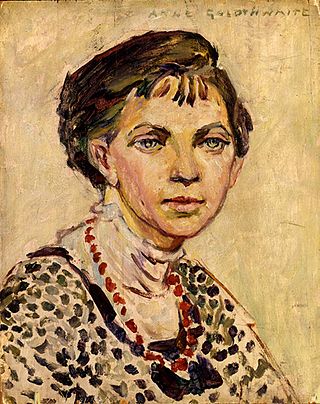
Anne Goldthwaite was an American painter and printmaker and an advocate of women's rights and equal rights. Goldthwaite studied art in New York City. She then moved to Paris where she studied modern art, including Fauvism and Cubism, and became a member of a circle that included Gertrude Stein, Henri Matisse, and Pablo Picasso. She was a member of a group of artists that called themselves Académie Moderne and held annual exhibitions.
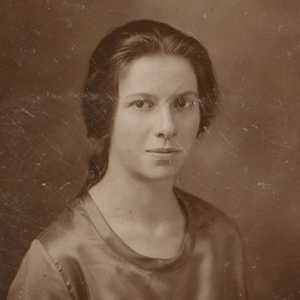
Gertrude Glass Greene was an abstract sculptor and painter from New York City. Gertrude and her husband, artist Balcomb Greene, were heavily involved in political activism to promote mainstream acceptance of abstract art. They were founding members of the American Abstract Artists organization.
Louis K. Meisel is an American author, art dealer and proponent of the photorealist art movement, having coined the term in 1969. He is also the owner of one of the earliest art galleries in SoHo at 141 Prince Street. In addition to Photorealism, Meisel is responsible for the resurgence of interest in the sub-set of American illustration identified as "Pin-up", and is the largest collector of original art of both genres. Louis and Susan Meisel own the largest collections of Photorealism and pin-up art in the world.
Holly Trostle Brigham is an American figurative painter whose feminist self-portraiture focuses on female subjects drawn from mythology and history.
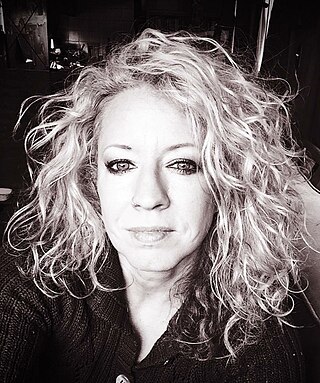
Cheryl Kelley is an American painter known for her photorealism, especially her paintings of classic and muscle cars. Her work has been featured on the cover of Harper's Magazine and can be seen at the Scott Richards Contemporary Art gallery in San Francisco, California, the Bernarducci·Meisel Gallery in New York City, New York, and the Seven Bridges Foundation in Greenwich, Connecticut. In 2009 and 2011 she was a finalist for the Hunting Art Prize, and in 2012 she received a Pollock-Krasner Foundation grant. The art collectors' resource Artsy considers her one of ten "Masters of Photorealism".
Marilyn (Vanitas) is an oil over acrylic on canvas painting by Audrey Flack executed in 1977. It has the dimensions of 96 x 96 inches. This contemporary piece is part of a collection Flack compiled titled Vanitas. It focuses heavily on an intensely colored, realistic presentation, symbolism dating back to historical work, formal sources, and historical context. The work is in the collection of the University of Arizona Museum of Art.



